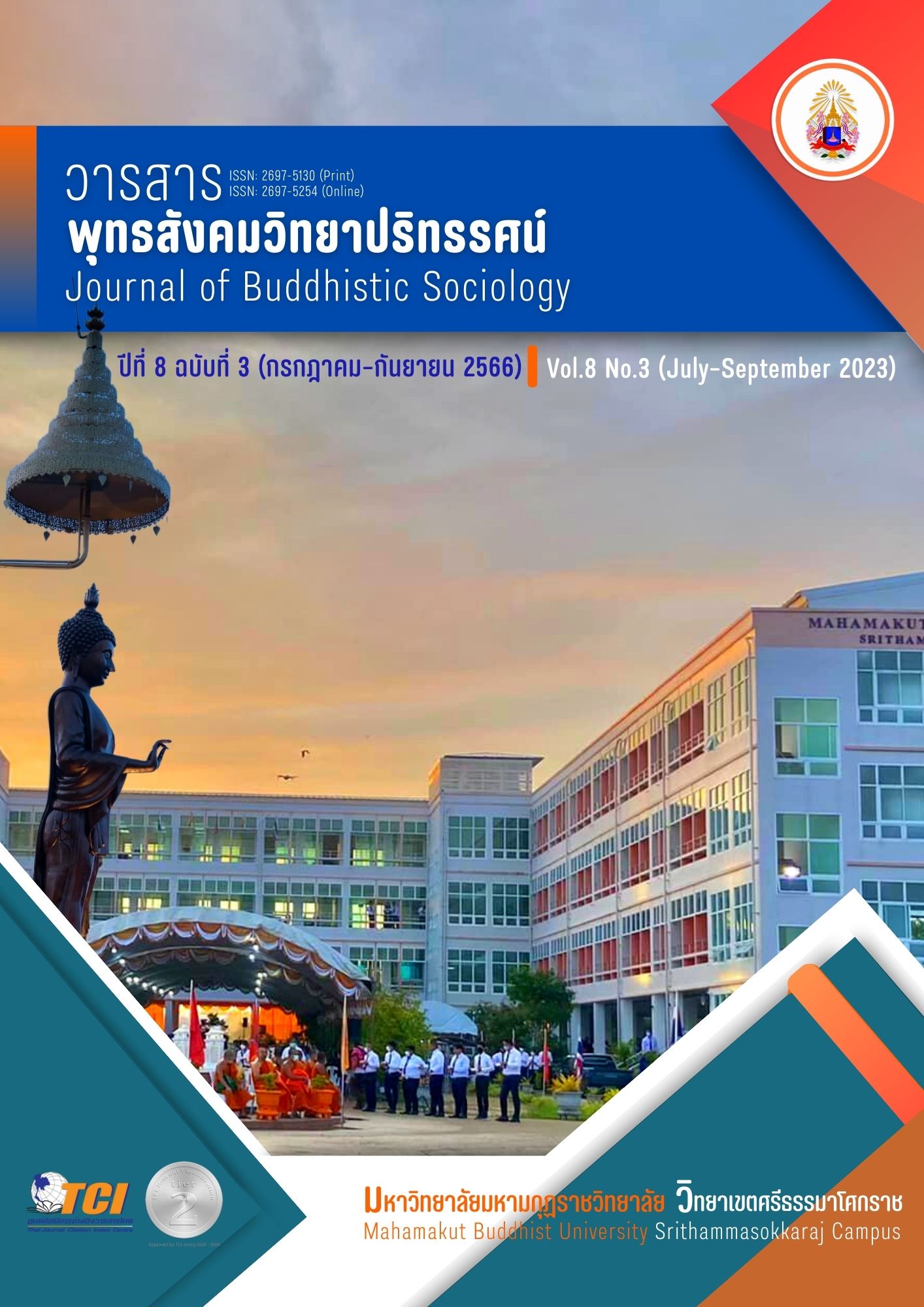A DITTHADHAMMIKATTHA PRINCIPAL ECONOMICS BASED INSTRUCTIONAL SYSTEM TO DEVELOP LIFESTYLE SUFFICIENCY DESIRABLE CHARACTERISTICS OF LOWER SECONDARY IN EASTERN THAILAND: A CASE OF THE PHRAPARIYATTIDHAMMA WATSOTHONWARARAM SCHOOL
Main Article Content
Abstract
The objective of this research was: 1) study knowledge about A Ditthadhammikattha Principal Economics Based Instructional System to Develop Lifestyle Sufficiency Desirable Characteristics of Lower Secondary in Eastern Thailand: A Case of The Phrapariyattidhamma Watsothonwararam School 2) Assess the need for the teaching system, 3) Develop a conceptual framework for the teaching system, 4) Develop the teaching system, and 5) Test the efficiency and certify the teaching system quality. The samples used include 20 qualified teachers of economics or related persons, and 2) 36grand 9students of The Phrapariyattidhamma Watsothonwararam School.The sample group according to the qualifications specified by the researcher included 20 economics teachers, 13 curriculum and teaching experts, and 36 Mathayom 3 students of Phrapariyattidhama Wat Sothonwararam School by purposive sampling. Statistics used in data analysis include mean, percentage, standard deviation. percentile Finding precision and finding the confidence value of the questionnaire.
The research results found that;
1. The results of a cognitive study about A Ditthadhammikattha Principal Economics Based Instructional System to Develop Lifestyle Sufficiency Desirable Characteristics of Lower Secondary in Eastern Thailand: A Case of The Phrapariyattidhamma Watsothonwararam School. It consists of 3 aspects: 1) the knowledge of the teaching system 2) The knowledge in teaching economics is based on the principle of A Ditthadhammikattha. 3) Knowledge of the development of desirable characteristics for sufficiency living.
2. The results of the assessment of teaching system needs revealed that teachers had needs in 5 areas: 1) Content 2) Teaching and learning activities 3) Teaching and learning based on the Titthadhammikattha principle 4) Evaluation 5) Teachers and learners.
3. The results of developing a conceptual framework for teaching economics based on Tithadhammikattha It consists of 5 components: 1) Context 2) Input 3) Process 4) Output and 5) Feedback.
4. The results of developing an economics teaching system based on the Ditthadhammikattha principle were at the highest level.
5. Efficiency test results E1 / E2 equal to 84.08/ 85.42, which is in accordance with the specified criteria, namely 85/85, the results of the assessment of desirable characteristics for sufficiency living are at a high level and the certification results the teaching system from all 7 experts is at the highest level.
Article Details

This work is licensed under a Creative Commons Attribution-NonCommercial-NoDerivatives 4.0 International License.
References
ชัยยงค์ พรหมวงศ์. (2520). ระบบสื่อการสอน. กรุงเทพมหานคร: สำนักพิมพ์แห่งจุฬาลงกรณ์มหาวิทยาลัย.
ชัยยงค์ พรหมวงศ์. (2523). ระบบสื่อการสอนในชุดวิชาเทคโนโลยีและสื่อสารการศึกษา เล่ม 1 หน่วยที่ 1-5. นนทบุรี: มหาวิทยาลัยสุโขทัยธรรมาธิราช.
ชัยยงค์ พรหมวงศ์. (2554). ระบบสื่อการสอนสำหรับการศึกษาขั้นพื้นฐาน. ใน หน่วยที่ 2 เอกสารการสอนชุดวิชาสื่อกับการศึกษาขั้นพื้นฐาน. นนทบุรี: สาขาวิชาศึกษาศาสตร์มหาวิทยาลัยสุโขทัยธรรมาธิราช.
นิทัศน์ วิเทศ. (2542). โลกาภิวัฒน์กับกฏหมาย. กรุงเทพมหานคร: พิมพ์ดี.
พระมหาอภิพงค์ คำหงษา. (2566). ระบบการสอนเศรษฐศาสตร์อิงหลักทิฎฐธัมมิกกัตถะ เพื่อพัฒนาคุณลักษณะอันพึงประสงค์ในการดำรงชีพพอเพียงของนักเรียนชั้นมัธยมยมศึกษาตอนต้น โรงเรียนพระปริยัติธรรมภาคตะวันออก: กรณีศึกษา โรงเรียนพระปริยัติธรรมวัดโสธรวราราม. ใน ครุศาสตรดุษฎีบัณฑิต สาขาวิชาการสอนสังคมศึกษา. มหาวิทยาลัยมหาจุฬาลงกรณราชวิทยาลัย.
สงัด อุรานันท์. (2532). เทคนิคการจัดการเรียนการสอนอย่างเป็นระบบ. กรุงเทพมหานคร: ภาควิชาบริหารการศึกษา. จุฬาลงกรณ์มหาวิทยาลัย.
สำนักงานคณะกรรมการการศึกษาแห่งชาติ. (ม.ป.ป.). พระราชบัญญัติการศึกษาแห่งชาติ พ.ศ. 2542 และที่แก้ไขเพิ่มเติม ฉบับที่ 4 พ.ศ. 2562. เรียกใช้เมื่อ 18 สิงหาคม 2565 จาก http://regu.tu.ac.th/quesdata/Data/L32.PDF
สิริวรรณ ศรีพหล. (2540). เอกสารประกอบการสอนชุดวิทยาการสอน (พิมพ์ครั้งที่ 15). นนทบุรี: โครงการส่งเสริมการแต่งตำรามหาวิทยาลัยสุโขทัยธรรมาธิราช.
Dick W. & Carey L. (1989). The systematic design of instruction. Glenview IL: Scott Foresman and Company.
Gerlach V. S. & Ely D. P. (NJ). Teaching, and media: A systematic approach, Englewood Cliffs. Prentice-Hall: 1980.
Kemp, J. E. (1988). he instructional design process. New York: Harper & Row, Publishers.
Kibler, R. J. (1974). Behavioral objectives, and instructional process. selected reading for the introduction to the teaching profession, Edited by Milton Muse. Berkeley: Wireman.


